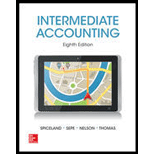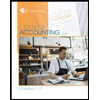
INTERMEDIATE ACCOUNTING
8th Edition
ISBN: 9780078025839
Author: J. David Spiceland
Publisher: McGraw-Hill Education
expand_more
expand_more
format_list_bulleted
Concept explainers
Textbook Question
Chapter 2, Problem 2.12BE
Closing entries
• LO2–7
The year-end adjusted
Expert Solution & Answer
Want to see the full answer?
Check out a sample textbook solution
Students have asked these similar questions
19. Which is not an objective of internal controls?A. Safeguard assetsB. Improve profitsC. Ensure accurate recordsD. Promote operational efficiencyhelp
You invest 60% of your money in Asset A (expected return = 8%, standard deviation = 12%) and 40% in Asset B (expected return = 5%, standard deviation = 8%). The correlation coefficient between the two assets is 0.3. What is the expected return and standard deviation of the portfolio?correct solut
You invest 60% of your money in Asset A (expected return = 8%, standard deviation = 12%) and 40% in Asset B (expected return = 5%, standard deviation = 8%). The correlation coefficient between the two assets is 0.3. What is the expected return and standard deviation of the portfolio?need jelp
Chapter 2 Solutions
INTERMEDIATE ACCOUNTING
Ch. 2 - Explain the difference between external events and...Ch. 2 - Each economic event or transaction will have a...Ch. 2 - What is the purpose of a journal? What is the...Ch. 2 - Explain the difference between permanent accounts...Ch. 2 - Describe how debits and credits affect assets,...Ch. 2 - Describe how debits and credits affect temporary...Ch. 2 - What is the first step in the accounting...Ch. 2 - Prob. 2.8QCh. 2 - Prob. 2.9QCh. 2 - Prob. 2.10Q
Ch. 2 - What is an unadjusted trial balance? An adjusted...Ch. 2 - Define adjusting entries and discuss their...Ch. 2 - Define closing entries and their purpose.Ch. 2 - Define prepaid expenses and provide at least two...Ch. 2 - Deferred revenues represent liabilities recorded...Ch. 2 - Define accrued liabilities. What adjusting journal...Ch. 2 - Prob. 2.17QCh. 2 - [Based on Appendix A] What is the purpose of a...Ch. 2 - [Based on Appendix B] Define reversing entries and...Ch. 2 - [Based on Appendix C] What is the purpose of...Ch. 2 - Prob. 2.21QCh. 2 - Transaction analysis LO21 The Marchetti Soup...Ch. 2 - Journal entries LO22 Prepare journal entries for...Ch. 2 - Prob. 2.3BECh. 2 - Journal entries LO22 Prepare journal entries for...Ch. 2 - Adjusting entries LO25 Prepare the necessary...Ch. 2 - Adjusting entries; income determination LO24,...Ch. 2 - BE2–7
Adjusting entries
• LO2–5
Prepare the...Ch. 2 - Prob. 2.8BECh. 2 - Prob. 2.9BECh. 2 - BE2–10
Financial statements
The following account...Ch. 2 - Prob. 2.11BECh. 2 - Closing entries LO27 The year-end adjusted trial...Ch. 2 - Prob. 2.13BECh. 2 - Prob. 2.1ECh. 2 - Prob. 2.2ECh. 2 - Prob. 2.3ECh. 2 - Prob. 2.4ECh. 2 - Prob. 2.5ECh. 2 - Debits and credits LO22 Indicate whether a debit...Ch. 2 - Prob. 2.7ECh. 2 - Prob. 2.8ECh. 2 - Prob. 2.9ECh. 2 - Prob. 2.10ECh. 2 - Prob. 2.11ECh. 2 - Prob. 2.12ECh. 2 - Prob. 2.13ECh. 2 - Prob. 2.14ECh. 2 - Prob. 2.15ECh. 2 - Prob. 2.16ECh. 2 - Prob. 2.17ECh. 2 - Prob. 2.18ECh. 2 - Prob. 2.19ECh. 2 - Prob. 2.20ECh. 2 - Reversing entries Appendix 2B The employees of...Ch. 2 - Prob. 2.22ECh. 2 - Prob. 2.23ECh. 2 - Special journals Appendix 2C The White Companys...Ch. 2 - Prob. 2.25ECh. 2 - Prob. 1CPACh. 2 - Prob. 2CPACh. 2 - 3. Compared to the accrual basis of accounting,...Ch. 2 - Prob. 4CPACh. 2 - Prob. 5CPACh. 2 - Prob. 2.1PCh. 2 - Prob. 2.2PCh. 2 - Prob. 2.3PCh. 2 - Prob. 2.4PCh. 2 - Prob. 2.5PCh. 2 - Prob. 2.6PCh. 2 - Prob. 2.7PCh. 2 - Prob. 2.8PCh. 2 - Prob. 2.9PCh. 2 - P2–10
Accrual accounting; financial...Ch. 2 - Prob. 2.11PCh. 2 - Prob. 2.12PCh. 2 - Prob. 2.13PCh. 2 - Judgment Case 21 Cash versus accrual accounting;...Ch. 2 - Judgment Case 2–2
Cash versus accrual...Ch. 2 - Communication Case 23 Adjusting entries LO24 I...
Knowledge Booster
Learn more about
Need a deep-dive on the concept behind this application? Look no further. Learn more about this topic, accounting and related others by exploring similar questions and additional content below.Similar questions
- I mistakenly submitted blurr image please comment i will write values. please dont Solve with incorrect values otherwise unhelpful.no aiarrow_forward1) Identify whethere the company is paying out dividends based on the attached statement. 2) Describe in detail how that the company’s dividend payouts have changed over the past five years. 3)Describe in detail the changes in “total equity” (representing the current “book value” of the company).arrow_forwardWhich is not an objective of internal controls?A. Safeguard assetsB. Improve profitsC. Ensure accurate recordsD. Promote operational efficiencyneed helparrow_forward
- Which is not an objective of internal controls?A. Safeguard assetsB. Improve profitsC. Ensure accurate recordsD. Promote operational efficiencyno aiarrow_forwardCan you solve this general accounting problem using appropriate accounting principles?arrow_forwardWhich is not an objective of internal controls?A. Safeguard assetsB. Improve profitsC. Ensure accurate recordsD. Promote operational efficiency no aiarrow_forward
- Need Answer with general Accounting Solving Methodarrow_forwardPlease provide the correct answer to this financial accounting problem using valid calculations.arrow_forward20 Nelson and Murdock, a law firm, sells $8,000,000 of four-year, 8% bonds priced to yield 6.6%. The bonds are dated January 1, 2026, but due to some regulatory hurdles are not issued until March 1, 2026. Interest is payable on January 1 and July 1 each year. The bonds sell for $8,388,175 plus accrued interest. In mid-June, Nelson and Murdock earns an unusually large fee of $11,000,000 for one of its cases. They use part of the proceeds to buy back the bonds in the open market on July 1, 2026 after the interest payment has been made. Nelson and Murdock pays a total of $8,456,234 to reacquire the bonds and retires them. Required1. The issuance of the bonds—assume that Nelson and Murdock has adopted a policy of crediting interest expense for the accrued interest on the date of sale.2. Payment of interest and related amortization on July 1, 2026.3. Reacquisition and retirement of the bonds.arrow_forward
arrow_back_ios
SEE MORE QUESTIONS
arrow_forward_ios
Recommended textbooks for you
 College Accounting, Chapters 1-27 (New in Account...AccountingISBN:9781305666160Author:James A. Heintz, Robert W. ParryPublisher:Cengage Learning
College Accounting, Chapters 1-27 (New in Account...AccountingISBN:9781305666160Author:James A. Heintz, Robert W. ParryPublisher:Cengage Learning

College Accounting, Chapters 1-27 (New in Account...
Accounting
ISBN:9781305666160
Author:James A. Heintz, Robert W. Parry
Publisher:Cengage Learning
The accounting cycle; Author: Alanis Business academy;https://www.youtube.com/watch?v=XTspj8CtzPk;License: Standard YouTube License, CC-BY